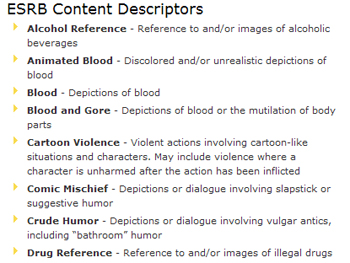
This week we’re examining the issues of video game violence and content in a multi-part series of interviews with industry insiders. And this is a tricky subject, because what might offend one individual won’t cause another to even blink. Content that might be fine for one gamer may truly disturb another. This is where the ratings were suppose to clear things up.
Today, all major video game releases receive a rating from the ESRB (Electronic Software Rating Board). This non-profit, self-regulating body was established in 1994 by the Entertainment Software Association (ESA), and it is this group that assigns computer and video game content ratings and enforces industry-adopted advertising guidelines.
According to the ESRB:
“The rating system is voluntary, although virtually all games that are sold at retail in the U.S. and Canada are rated by the ESRB. Many retailers, including most major chains, have policies to only stock or sell games that carry an ESRB rating, and most console manufacturers will only permit games that have been rated by ESRB to be published for their platforms.”
Information on how the ratings work, and how they’re determined can be found on the ESRB Web site.
 However, as we’ve already touched upon the ratings were developed in 1994, and in part due to the content of games such as Mortal Kombat. At that time there were two major console players including Nintendo and SEGA, and since then we’ve seen three generations of hardware improvements. Is it time to revisit the ratings?
However, as we’ve already touched upon the ratings were developed in 1994, and in part due to the content of games such as Mortal Kombat. At that time there were two major console players including Nintendo and SEGA, and since then we’ve seen three generations of hardware improvements. Is it time to revisit the ratings?
Crunchgear interview ESRB spokesman Eliot Mizrachi in part one of our week-long series on video game content:

Crunchgear: Since the introduction of the ratings in 1994 the graphic detail has greatly increased, and thus games look more realistic. Has this been considered at all, at least in terms of whether game ratings should be readdressed? Games in 1994 looked much more like cartoons than today’s games, which are close to photo-realistic, so is this being considered?
Eliot Mizachi: The degree of graphic detail and realism has always been and will continue to be among the considerations taken into account by raters, along with other elements like the degree of player control, reward system, context and overall level of intensity.
CG: In terms of violence and sex, I know that the AO (Adults Only) rating was created for games that “may include prolonged scenes of intense violence and/or graphic sexual content and nudity” (ESRB Web site). But has any title to date actually received an AO rating for violence or more importantly subject matter?
EM: Absolutely. We’ve rated games AO for sexually explicit, extremely violent or other types of adult content, such as real gambling. It’s important to point out that we’ve assigned the AO rating more often than it actually remains as the final rating. Publishers always have the option of revising their game’s content and resubmitting it to ESRB, and oftentimes they do so given the limited ability to get broad distribution for a game that carries an AO rating.
CG: And in truth hasn’t the AO rating to some extent become akin to the NC-17 rating for movies, where it is still seen to be for content that is pornographic in nature?
EM: Sexually explicit content may tend to result in an AO rating more readily than does other content, a judgment that merely reflects our cultural norms and community standards. However, the AO rating is intended to communicate that the content in the game goes beyond what is typically socially or culturally acceptable for young adults, and most certainly unacceptable for all children no matter what age, whether it be due to sexual content or not. Additionally, it should be noted that content does not need to qualify as “pornographic” or obscene to warrant an AO rating assignment. In this respect, our AO rating is no different than the NC-17 rating.

CG: Discussing subject matter, where is the line drawn on plot, characters and overall goal of the game? My example: the Call of Duty franchise is rated Teen, but the World War II franchise Brothers in Arms is rated Mature. The difference seems to be the depiction of blood and some harsh language. But Doom3 was also rated Mature, and that seemed much more violent and graphic, and finally Scarface was also Mature. This game features a character that is a drug dealer, fights law enforcement as part of the process to “win” and is able to randomly beat up innocent people.
So my question is where is the line in terms of what is Mature and what might be considered Adults Only?
EM: With only six rating categories, we are obviously dealing with varying degrees of intensity for each grouping for age appropriateness. When a Mature rating is assigned, our raters believe the content and context of that game is most appropriate for ages 17 and older. Obviously no two games are identical, and so a game will always reside somewhere along the spectrum of a given category. That’s why content descriptors come in so handy.
To use your examples, Doom3 was rated Mature with descriptors for “Blood and Gore” and “Intense Violence,” whereas Scarface carried those two descriptors in addition to “Sexual Themes”, “Strong Language” and “Use of Drugs.” The additional descriptors indicate the differences in content in each game, and that’s why we encourage parents to use both parts of the system when choosing games.
When a Mature rating is assigned, we believe that communicates a sufficiently strong warning that a particular game is typically not appropriate for children. Therefore, in order for a game to warrant an AO rating, it must include content that goes beyond what is generally considered appropriate for young adults and most certainly is unacceptable for all children no matter what age. And ultimately that’s a judgment call our raters make based on a wide range of factors, to which I spoke earlier. Moreover, research regularly conducted by Peter D. Hart Research Associates with over 400 parents shows that the vast majority of the time parents agree with our Mature rating assignments. And, finally, it also bears mentioning that the FTC’s recently released report on the Marketing of Violent Entertainment to Children found that 88% of parents said the ESRB does an “excellent,” “good,” or “fair” job of informing them of the violent content in games.
CG: While there are descriptors for the use of alcohol and drugs, this isn’t really defined to whether the alcohol and/or drugs are being used by the player’s character or a non-player character. Is this factored in at all during the rating’s process? What I’m asking is alcohol depiction considered in the context? Such as if you play a game based on the life of Elliot Ness and you’re enforcing prohibition vs. a game where you’re alcoholic gangster?
 EM: We have descriptors for both “Use of” tobacco, alcohol and drugs as well as “Reference to” those substances. The “Reference” descriptor is more likely to pertain to a depiction or dialogue whereas the “Use of” descriptor entails exactly that, whether by the player or another character in the game. Context of a depiction is always a consideration in the assignment of ratings. For example, the contextual depiction of sipping sacramental wine in a religious ceremony may not warrant a “Use of Alcohol” descriptor whereas the drinking habits of your “alcoholic gangster” would be more likely to. Of course, content descriptors are assigned in context of the rating category assigned, so such depictions in an E-rated game, for example, would be more likely to result in a descriptor than would such a depiction in an M-rated game, which may include warnings about other types of content that may pose greater cause for concern, have had much greater impact on the overall experience of playing the game and, as such, the rating category assigned.
EM: We have descriptors for both “Use of” tobacco, alcohol and drugs as well as “Reference to” those substances. The “Reference” descriptor is more likely to pertain to a depiction or dialogue whereas the “Use of” descriptor entails exactly that, whether by the player or another character in the game. Context of a depiction is always a consideration in the assignment of ratings. For example, the contextual depiction of sipping sacramental wine in a religious ceremony may not warrant a “Use of Alcohol” descriptor whereas the drinking habits of your “alcoholic gangster” would be more likely to. Of course, content descriptors are assigned in context of the rating category assigned, so such depictions in an E-rated game, for example, would be more likely to result in a descriptor than would such a depiction in an M-rated game, which may include warnings about other types of content that may pose greater cause for concern, have had much greater impact on the overall experience of playing the game and, as such, the rating category assigned.
CG: I can attest that when I’ve asked game developers/producers if they think any child under 18 should be playing a certain title, I have heard, “well, we see this as a game for adults.” So I have to ask, why isn’t it rated AO then?
EM: One could always argue that ratings should be more or less restrictive depending on their own personal views. Going back to what I said earlier, 82% of the time parents agree with our ratings, and another 5% think we’re too strict. The overwhelming majority of the time, parents agree with the Mature rating assignments, too. The FTC’s recent Report also found considerable agreement with the ESRB ratings among parents, as well as 87% saying they are “very” to “somewhat” satisfied with the ratings we assign. Given the diversity of values and opinions in this country, these are significant levels of agreement and satisfaction, and we’re very committed to ensuring that our ratings remain reflective of consumers’ expectations about content. But at the end of the day, whether you assign an M or an AO rating, those games are labeled as being inappropriate for younger ages, and the difference is really just a matter of intensity or extremity.
CG: I think it is safe to say that most publishers would fight an AO rating because it would make it harder to sell, but considering the factors I’ve discussed such as more realistic graphics, do you foresee a time when this rating might be necessary for more graphically intense depictions of violence?
EM: I can’t stress enough that the ESRB has no reluctance whatsoever to assign the AO rating when it’s warranted, even if it’s for violent or other non-sexual content. It’s impossible to predict what the future holds; all we can do is continue to assign ratings that provide reliable guidance to consumers and inform their purchase decisions.